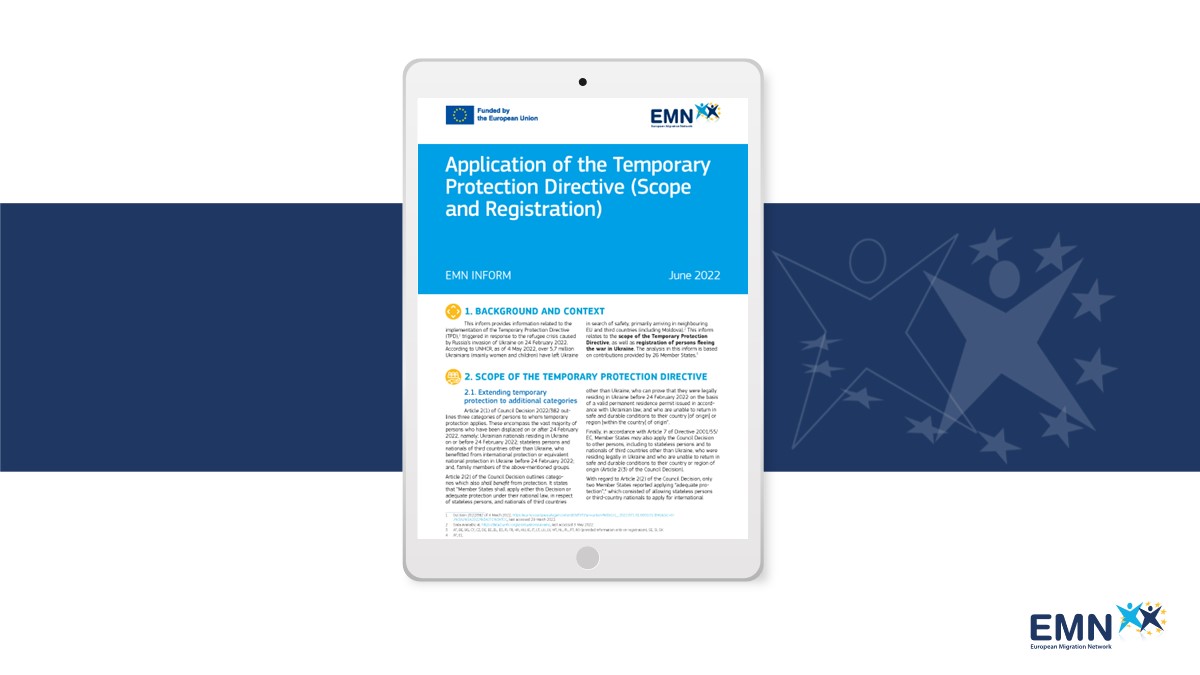New EMN inform published: Application of the Temporary Protection Directive for displaced persons
05.07.2022According to UNHCR, over 5.4 million Ukrainians have left Ukraine in search of safety, primarily arriving in neighbouring EU and third countries (including Moldova).[1] This inform outlines the scope of the Temporary Protection Directive and the registration processes in place for persons fleeing the war in Ukraine. The analysis in this inform is based on contributions provided by 26 Member States.[2]
The Temporary Protection Directive was first activated by the Council on 4 March 2022 in response to the refugee crisis caused by Russia’s invasion of Ukraine on 24 February.[3] This inform outlines the scope of the Temporary Protection Directive and the registration processes in place for persons fleeing the war in Ukraine. The analysis in this inform is based on contributions provided by 26 Member States.[4]
Article 2(1) of Council Decision 2022/382 outlines three categories of persons to whom temporary protection applies: (i) Ukrainian nationals residing in Ukraine on or before 24 February 2022; (ii) stateless persons and nationals of third countries other than Ukraine, who benefitted from international protection or equivalent national protection in Ukraine before 24 February 2022; and (iii) family members of the abovementioned groups. Whilst the Temporary Protection Directive allows Member States to have national complementary schemes in place, the majority of responding Member States[5] reported applying temporary protection exclusively under the Temporary Protection Directive.
For Ukrainian nationals who were already present on the territory of a Member State before the invasion, Member States have applied different measures. Many Member States reported taking measures to enable Ukrainian nationals legally residing on their territory to remain even after their visas or other legal basis of stay had expired. Others requested that people apply for an extension of their current permit, request temporary protection, or apply for asylum.[6] A few Member States reported extending protection to persons who had only temporarily left Ukraine before the outbreak of the conflict, and who were unable to return to Ukraine.[7] With regard to Ukrainian nationals in an irregular situation, a few Member States reported stipulating that such individuals would be given a legal basis for temporary stay and that any return decision was thereby postponed or invalidated.
Read the new inform HERE.
References:
[1] UNHCR Operational Data Portal – Ukraine Refugee Situation, https://data.unhcr.org/en/situations/ukraine, last accessed on 4 July 2022.
[2] AT, BE, BG, CY, CZ, DE, EE, EL, ES, FI, FR, HR, HU, IE, IT, LT, LU, LV, MT, NL, PL, PT, RO (provided information only on registration), SE, SI, SK.
[3] Decision 2022/382 of 4 March 2022, https://eur-lex.europa.eu/legal-content/EN/TXT/?uri=uriserv%3AOJ.L_.2022.071.01.0001.01.ENG&toc=OJ%
3AL%3A2022%3A071%3ATOC, last accessed 4 July 2022.
[4] AT, BE, BG, CY, CZ, DE, EE, EL, ES, FI, FR, HR, HU, IE, IT, LT, LU, LV, MT, NL, PL, PT, RO (provided information only on registration), SE, SI, SK.
[5] BE, BG, CY, CZ, DE, EE, EL, ES, FI, FR, HR, HU, IE, IT, LU, LV, MT, NL, PL, PT, SI, SE, SK (starting on 1 March 2022 temporary protection was part of a national protection scheme, but after the adoption of the Council Decision, temporary protection status is exclusively under the Temporary Protection Directive).
[6] BE, CZ (persons who have been illegally staying in the territory of the Czech Republic prior to 24 February 2022 and are not entitled to temporary protection have to apply for a visa for a stay of over 90 days to remain in the territory) DE, FI, FR, LV, SK.
[7] CZ, ES (only if they were in Spain before 24 February 2022), LT (only if they left Ukraine after 24 January 2022), LV, PL.
